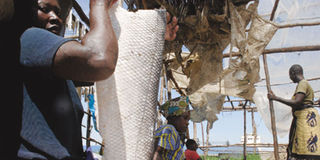Premium
Women group scrapes a living from fish skins

PHOTO | TOM OTIENO A worker displays a scale-free fish skin as others scrape the waste in Obunga slums in Kisumu.
What you need to know:
- Using Nile perch skin, the group has been making shoes and belts that are popular among residents and visitors
- The group’s leader, Mrs Seline Opondo, said that skins are obtained from Nile perch waste products from a nearby fillet processing plant in Obunga slums
- Use of fish leather is becoming popular especially in the lake side region with government agencies and CBOs working in tandem to create value out of the resource until recently considered as waste
A group of women at an informal settlement in Kisumu County are earning a living by making and selling unique products made from fish skin.
Using Nile perch skin, the group has been making shoes and belts that are popular among residents and visitors.
Obunga Women group was started two years ago, selling fish. Thanks to their saving culture, they were able to pool resources which went into the new venture.
The group’s leader, Mrs Seline Opondo, said that skins are obtained from Nile perch waste products from a nearby fillet processing plant in Obunga slums. “The waste products have been a blessing in disguise,” she said.
Raw materials are easily available given that Nile perch accounts for 70 per cent of the total fish catch from Lake Victoria.
“We get the waste products and peel off any flesh before moving to the next stage, which is tanning,” said Mrs Opondo.
High oil content
Tanning, which involves treating the skin to produce durable leather that is less susceptible to decomposition, takes a week given that fish has high oil content. Chemicals are also used to remove the oil.
Table salt is applied before drying them in the sun. The skins are churned, soaked, fleshed, and dried in the open air. Tanning prevents the leather from becoming stiff once all the oils are removed.
The leather is then use to make foot wear, handbags and other products that are developed by the group through the assistance of Kirdi.
The idea, which the women got from Kenya Industrial Research and Development (Kirdi), has since transformed their lives.
Use of fish leather is becoming popular especially in the lake side region with government agencies and CBOs working in tandem to create value out of the resource until recently considered as waste.
“Kirdi trained mongers on how to process fish skin into valuable leather shoes that can compete in both local and international markets,” said Mrs Opondo.
“Our items are made from rare and unique leathers. People look at them and are amazed,” she added.
Bring down cost
Mrs Opondo is optimistic that leather made from the fish skin could ultimately bring down the cost of footwear, given that the shoes are cheaper compared to imported ones.
Teenage Mothers and Girls Association of Kenya director Philomena Othacha said fish has emerged as a new alternative source of leather in what could potentially change Kenya’s leather manufacturing and fashion industry.
“The new sources could create a multi-million business for fish mongers in this region. All that is required is government support especially to enable traders access loans to expand the business,” said Ms Othacha.
Members of the women group said that lack of ready market for their products remains a big challenge.
Mrs Mary Onyango, a cobbler said that fish leather shoes will soon be the in-thing in the fashion industry. “Fish skins can also be processed into Suede and other high end products which are water and scratch proof,” she said.
A pair of shoes made from fish skin leather goes for Sh1,000 in the local market and Sh1,500 if sold outside while a handbag made from the same costs Sh6,000 locally.
The final products spot unique fish-scale patterns while maintaining the soft texture of leather.
The women urged the government to stem the inflow of cheap low quality imports and second hand footwear and leather products which is slowly killing the local sub-sector.
Magnam Environmental Network official Michael Nyaguti said that the stock of Nile perch is dwindling due to use of illegal gears adding that overfishing could kill the sub sector.
“Stocks of Nile perch have really declined and getting very big fish to enable fish mongers get large skins has been a great challenge,” he said.
According to the Economic survey 2010, production of leather and footwear registered a significant growth of 36.5 per cent mainly driven by leather shoes which shot up by 46.5 per cent in 2009.




